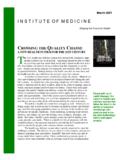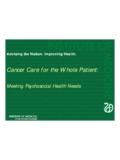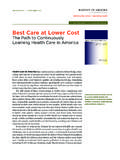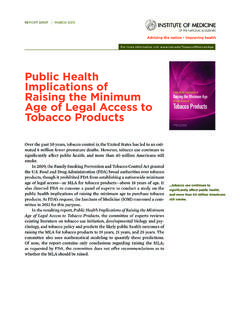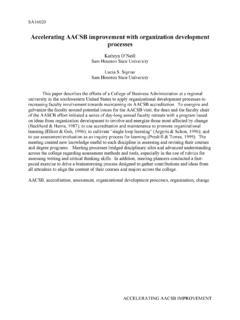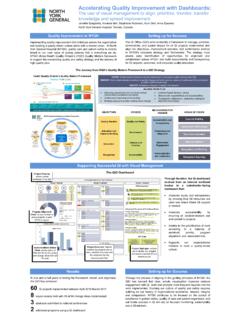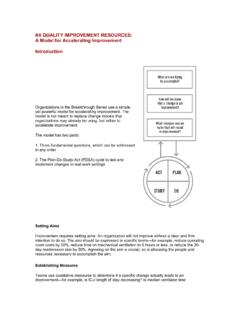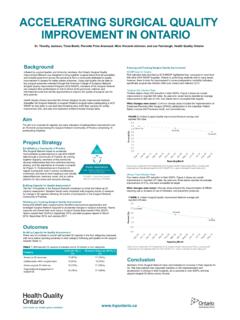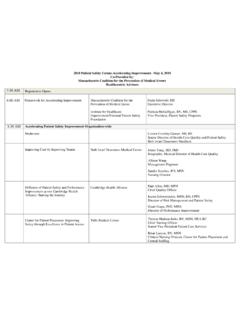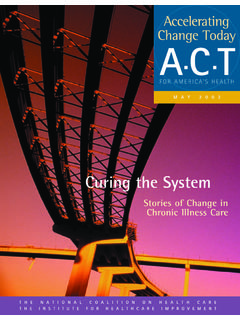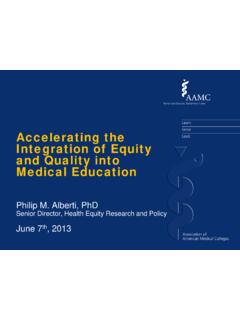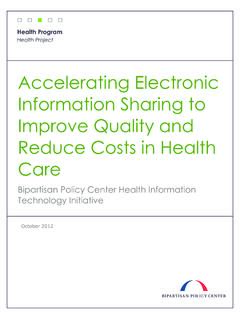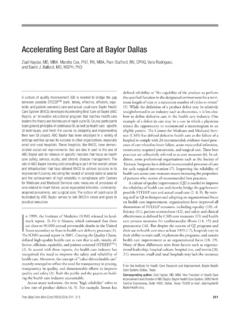Transcription of PERFORMANCE MEASUREMENT ACCELERATING …
1 REPORT BRIEF DECEMBER 2005. PERFORMANCE MEASUREMENT : ACCELERATING improvement . Our health care system does not consistently deliver safe and effective care for all of our citizens despite enormous expenditures and startling breakthroughs in biomedical research and technology. PERFORMANCE MEASUREMENT is essential to accelerate improvement in health system quality . Congress, concerned about the uneven, often sub-optimal, quality of care and slow pace of improvement , mandated in the Medicare Modernization Act of 2003 that the Institute of Medicine (IOM) should examine specific aspects of the quality improvement infrastructure.
2 In response, the IOM has produced a series of reports, Pathways to quality Health Care, which is sponsored by the Centers for Medicare and Medicaid Services. This report is the first of three in response to the congressional request; it focuses on PERFORMANCE MEASUREMENT and recommends a starter set of PERFORMANCE measures. Later reports in the series examine other PERFORMANCE improvement strategies, includ- The typical American ing payment incentives for health providers and the strengthening of adult receives recom- Medicare's quality improvement Organization program to offer tech- mended health care nical support to providers.
3 Only slightly more IMPROVING THE HEALTH OF AMERICANS than 50 percent of the time. The ultimate purpose of PERFORMANCE MEASUREMENT is to improve the health of everyone in the United States. PERFORMANCE measures are yardsticks by which all health care providers and organizations can determine how successful they are in delivering recommended care and improving patient outcomes for example, whether all diabetic patients receive regular blood tests and eye exams or if a facility's 30- day survival rate among cardiac bypass patients is increasing. Public reporting of PERFORMANCE data holds health providers accountable to PERFORMANCE meas- both consumers and purchasers of care; transparency builds trust.
4 Ures are building Patients can also learn what the expected professional standards of blocks for quality care are and where they can go to receive it. improvement . COORDINATING CURRENT PERFORMANCE MEASUREMENT . EFFORTS. A host of PERFORMANCE MEASUREMENT initiatives has emerged in recent years. They represent important breakthroughs in describing clinical effectiveness, quality improvement , and patient satisfaction. Governmental agencies, such as the Centers for Medicare and Advising the Nation. Improving Health. Medicaid Services and the Agency for Healthcare Research and quality , as well as private sector groups such as the National quality Forum, the National Committee for quality Assurance, the Joint Commission on Accreditation of Healthcare Organizations, and oth- ers have made pioneering efforts to move this field forward and to build upon each other's work.
5 But these independent voluntary initiatives have led to duplication in some areas, significant gaps in knowledge in others, and multiple independent reporting systems. Individual stakeholders understandably focus on certain features of care that they con- sider their highest priority for improvement . While these piecemeal efforts indicate progress, they impose serious duplicate reporting burdens on providers and confuse con- sumers. Also, they frequently overlook areas of national interest that are difficult for indi- Start now with vidual providers to quantify, such as population mortality rates.
6 Adoption of a Building on these previous efforts, IOM endorses a starter set of PERFORMANCE meas- standardized, ures that are currently acknowledged by major stakeholder groups and have a strong sci- evidence-based entific evidence base. The starter set includes: Ambulatory care quality Alliance measures, Consumer Assessment of Healthcare Providers and Systems (CAHPS). set of core Clinician and Group Survey, Hospital quality Alliance measures, CAHPS Hospital PERFORMANCE Survey, Health Plan Employer Data and Information Set (HEDIS), CAHPS Health Plan measures. Survey, nursing homes Minimum Data Set (MDS), home health Outcome and Assessment Information Set (OASIS), end-stage renal disease measures in the National Healthcare quality Report, and selected longitudinal measures of outcomes and efficiency.
7 IOM also recommends development of measures, based on rigorous research, to address certain aspects of care: Neglected areas of focus (efficiency, equity, and patient centeredness). Longitudinal care (care transitions between providers, mortality). Systems-level measures (doctor-specific mortality, hospital wide mortality). Shared accountability (among multiple practitioners and providers delivering care to the same patient). New measures are needed to Typically, PERFORMANCE MEASUREMENT has been provider-based, relating to hospitals, track patients nursing homes, physicians office or other care settings, rather than patient-based.
8 There with chronic is no accountability to monitor when a patient moves from one care setting to another or conditions across to ensure that care is timely enough to prevent avoidable hospitalizations or death. Left care settings unmeasured and with no one responsible, these areas are likely to be left unaddressed and time. and unchanged. Moving toward individual patient-level MEASUREMENT , reflecting the many medical conditions a patient may have, rather than using existing provider-based MEASUREMENT approaches can improve even the starter set of measures. This increased detail provides more flexibility to aggregate data in different ways to answer multiple research questions.
9 Additionally, composite measures can be tracked for complex patients who receive care from multiple providers. Measuring single measures can be misleading; one study shows that even though from 46 percent to 99 percent of diabetic patients received single ele- ments of recommended care, only 18 percent received the complete bundle. BUILDING A PERFORMANCE MEASUREMENT SYSTEM FROM A NON-SYSTEM. If reporting and payment systems are to be effective in improving quality , a univer- sally accepted system is needed to measure and fairly report on the PERFORMANCE of indi- vidual health care providers and organizations.
10 A federal role that only specifies a uni- form set of measures is not enough. No stakeholder currently has the authority, resources 2. or leverage to articulate national goals for health care and achieve the required degree of coordination. Inconsistencies persist among stakeholders relying on fragile consensus- driven procedures that often do not address important areas of need. Thus, IOM recommends establishing a new independent board National quality Coordination Board (NQCB) within the Department of Health and Human Services that will: Set clear short and long-term goals for improving the health care system, Designate, or if necessary develop, standardized PERFORMANCE measures, Ensure a data repository system capable of reliable, validated data collection at the individual patient level (public, private and uninsured)
